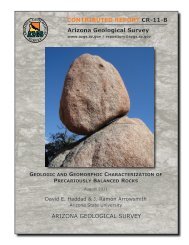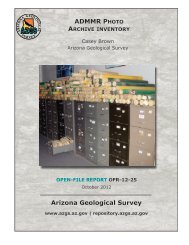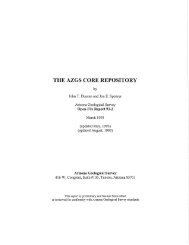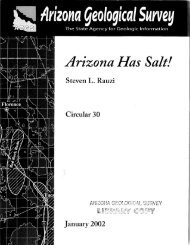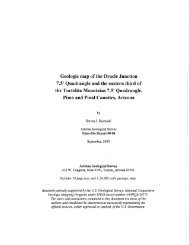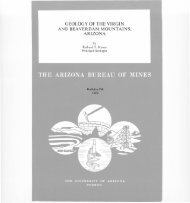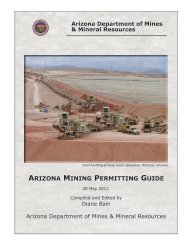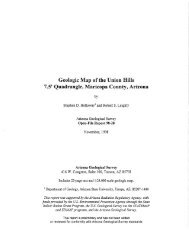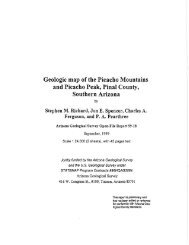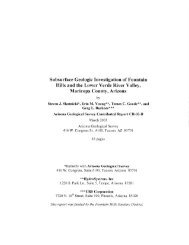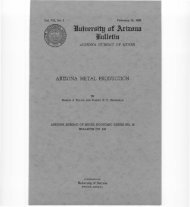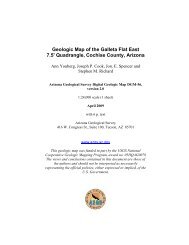Structural-Geologic Map Relationships in the Salcito Ranch Area,
Structural-Geologic Map Relationships in the Salcito Ranch Area,
Structural-Geologic Map Relationships in the Salcito Ranch Area,
You also want an ePaper? Increase the reach of your titles
YUMPU automatically turns print PDFs into web optimized ePapers that Google loves.
tim<strong>in</strong>g and style. In <strong>the</strong> late Oligocene-middle Miocene, between about 25 and 18 Ma<br />
(Crittenden and o<strong>the</strong>rs, 1980; Davis, 1980, 1981; Dick<strong>in</strong>son, 1991; Force, 1997; Davis<br />
and o<strong>the</strong>rs, 2004; Damon and Shafiqullah, 2006), <strong>the</strong> crust was extended by<br />
deformation accommodated by regional brittle-ductile shear zones, now expressed <strong>in</strong><br />
<strong>the</strong> form of metamorphic core complexes and detachment faults. Then, <strong>in</strong> middle<br />
Miocene-Pliocene time, between ~15 and 5 Ma, <strong>the</strong> crust was extended by deformation<br />
accommodated by normal faults that cross cut and exposed deep levels of <strong>the</strong> core<br />
complex. Rock fabrics and structural trends <strong>in</strong>dicate that local core-complex extension<br />
was NE-SW oriented, <strong>in</strong> contrast to later E-W Bas<strong>in</strong> and Range extension.<br />
The geology and regional tectonic significance of <strong>the</strong> Catal<strong>in</strong>a-R<strong>in</strong>con<br />
metamorphic core complex has received significant attention <strong>in</strong> <strong>the</strong> literature. This work<br />
focuses on late Oligocene-early Miocene shear<strong>in</strong>g and detachment fault<strong>in</strong>g circa 25 to<br />
20 Ma along <strong>the</strong> Catal<strong>in</strong>a brittle/ductile shear zone at <strong>the</strong> sou<strong>the</strong>ast corner of <strong>the</strong> R<strong>in</strong>con<br />
Mounta<strong>in</strong>s. The <strong>in</strong>ferred depth level for <strong>the</strong> most deformed (sheared) rock <strong>in</strong> <strong>the</strong> <strong>Salcito</strong><br />
<strong>Ranch</strong> area is ~10 km (Davis and o<strong>the</strong>rs, 2004). Though exposures of Bas<strong>in</strong> and<br />
Range faults are rare with<strong>in</strong> sou<strong>the</strong>rn Arizona, <strong>the</strong> <strong>Salcito</strong> <strong>Ranch</strong> area conta<strong>in</strong>s one of<br />
<strong>the</strong>se (<strong>the</strong> Mart<strong>in</strong>ez <strong>Ranch</strong> fault), which truncates <strong>the</strong> core-complex fabrics (Drewes,<br />
1974, 1977).<br />
Basic <strong>Map</strong> <strong>Relationships</strong><br />
We mapped <strong>the</strong> <strong>Salcito</strong> <strong>Ranch</strong> area at a scale of 1:6000 (see Plate 1, Figure 2).<br />
It conta<strong>in</strong>s a superb display of metamorphic core complex fabrics and structures.<br />
Mylonites, ultramylonities, and microbrecciated mylonites are very well exposed, and<br />
<strong>the</strong>y are derived from a granitic protolith. Fur<strong>the</strong>rmore, not only is <strong>the</strong> gently dipp<strong>in</strong>g<br />
5



